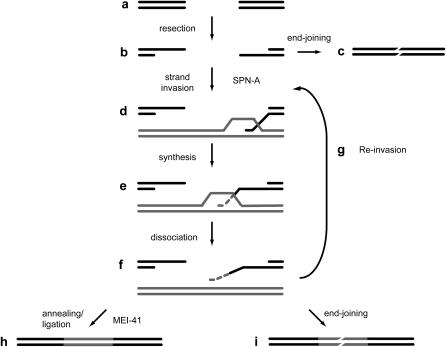Figure 2.—
Model for repair of a gap through SDSA. Processing of a double-strand gap (a) begins with resection of the ends to leave 3′-ended single-stranded overhangs (b). The resected structure can then enter one of two pathways. The ends can join through a process that does not require extensive complementary ends (c) or one or both of these resected ends invade a homologous template (d) and prime repair synthesis (e). The nascent strand is dissociated, searching for a complementary single-stranded DNA to anneal to f. This structure resembles that of a resected product (b). Consequently, the nascent strand can reinvade a homologous sequence (g) or undergo end joining (i). Repair synthesis is not processive, so multiple rounds of synthesis, dissociation, and reinvasion (e–g) are required for repair across the gap (McVey et al. 2004a). Synthesis across the entire gap allows annealing of complementary single-stranded DNA, resulting in restoration of sequences lost when the gap was originally made (h). In the absence of SPN-A (DmRad51), repair occurs through an end-joining pathway (c). In the absence of MEI-41 (h), a majority of repair products that attempt the annealing/ligation steps are lost, resulting in a reduction of complete SDSA.

